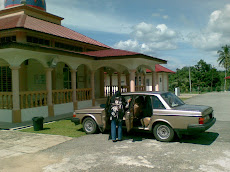Gambar-Gambar Gerhana Matahari (Jumaat 15 Jan 2010)

A combination picture shows the different phases of an annular solar eclipse in the southern Indian town of Rameswaram January 15, 2010. The annular eclipse of the sun, which will last for over 11 minutes during its maximum duration, will be visible from a 300-km wide

CHENGDU, CHINA – JANUARY 15: A partial solar eclipse is seen at the Tianfu Square on January 15, 2010 in Chengdu of Sichuan Province, China. An annular eclipse of the Sun is visible from within a 300-km-wide track that traverses half of Earth today including China, which is predicted to be the longest of its kind for 1000 years.



An airplane flies past a partial solar eclipse in Taipei, Taiwan, Friday, Jan. 15, 2010.

A bird is silhouetted against the sun during the formation of an annular solar eclipse in New Delhi, India, Friday, Jan. 15, 2010. Thousands of people in India viewed the spectacle of the eclipse of the sun looking skywards through special filter eyeglasses as the moon crosses its path blocking everything but a narrow, blazing rim of light. (AP Photo) ** INDIA OUT.

An annular solar eclipse is seen formed over the sky of Male, Maldives, Friday, Jan. 15, 2010. Thousands of people viewed the spectacle of the eclipse of the sun looking skywards through special filter eyeglasses as the moon crosses its path blocking everything but a narrow, blazing rim of light.

A man skates on a frozen lake in a park while the sun is seen partially blocked by the moon during a solar eclipse in Kaifeng, in central China’s Henan province, Friday, Jan. 15, 2010. The eclipse is known as an annular eclipse because the moon doesn’t block the sun completely.

The moon passes between the sun and the earth during a solar eclipse as seen in Changsha, Hunan province July 22, 2009. A total solar eclipse began its flight on Wednesday across a narrow path of Asia, where it was expected to darken the skies for millions of people for more than six minutes in some places.

People watch the annular solar eclipse at a planetarium in Bangalore, India, Friday, Jan. 15, 2010. Thousands of people in India viewed the spectacle of the eclipse of the sun looking skywards through special filter eyeglasses as the moon crosses its path blocking everything but a narrow, blazing rim of light.

Residents pray during a solar eclipse in Amman January 15, 2010. The annular eclipse of the sun, which will last for over 11 minutes during its maximum duration, will be visible from a 300-km wide track that passes half of the Earth, according to NASA.

People use solar viewers to view an annular solar eclipse at the Nehru planetarium in Mumbai January 15, 2010. The annular eclipse of Sun, which will last for over 11 minutes during it’s maximum duration, will be visible from a 300-km wide track that passes half of the Earth, according to NASA.

Residents watch a solar eclipse in Amman January 15, 2010. The annular eclipse of Sun, which will last for over 11 minutes during its maximum duration, will be visible from a 300-km wide track that passes half of the Earth, according to NASA.

People use photographic film strips to observe an annular eclipse near the Kibera slums in Kenya’s capital Nairobi, January 15, 2010. The annular eclipse of the sun, which will last for over 11 minutes during its maximum duration, will be visible from a 300-km wide track that passes half of the Earth, according to NASA. In Africa, the annular eclipse passed through Chad, Central African Republic, Democratic Republic of the Congo, Uganda, Kenya, and Somalia.





.jpg)





.jpg)




.jpg)
.jpg)




.jpg)
.jpg)

.jpg)
.jpg)
.jpg)
.jpg)
.jpg)
